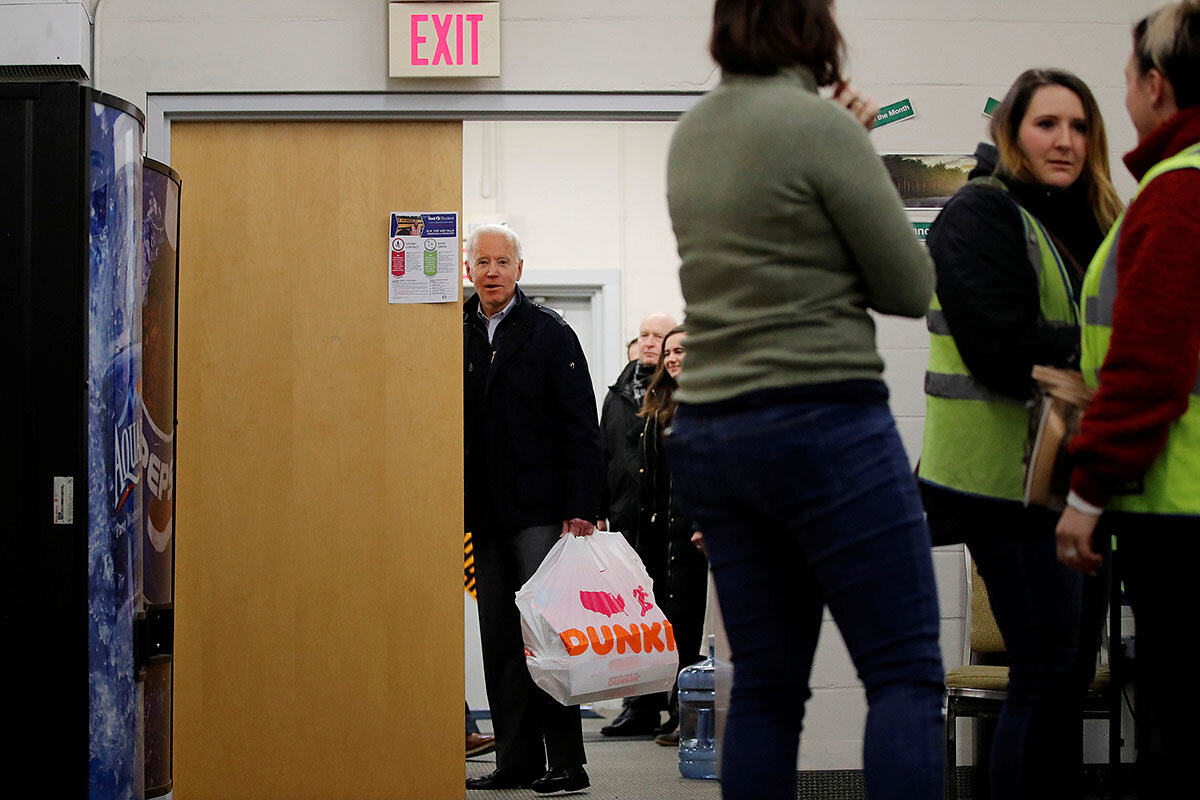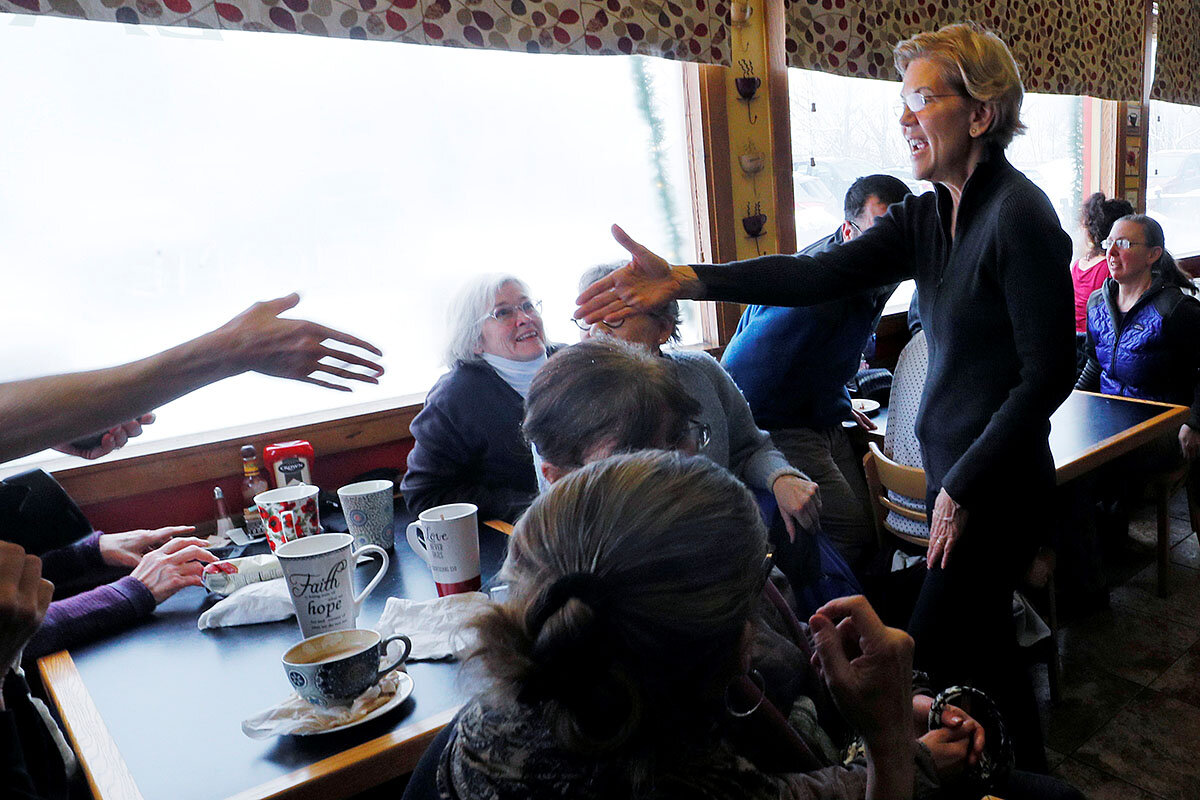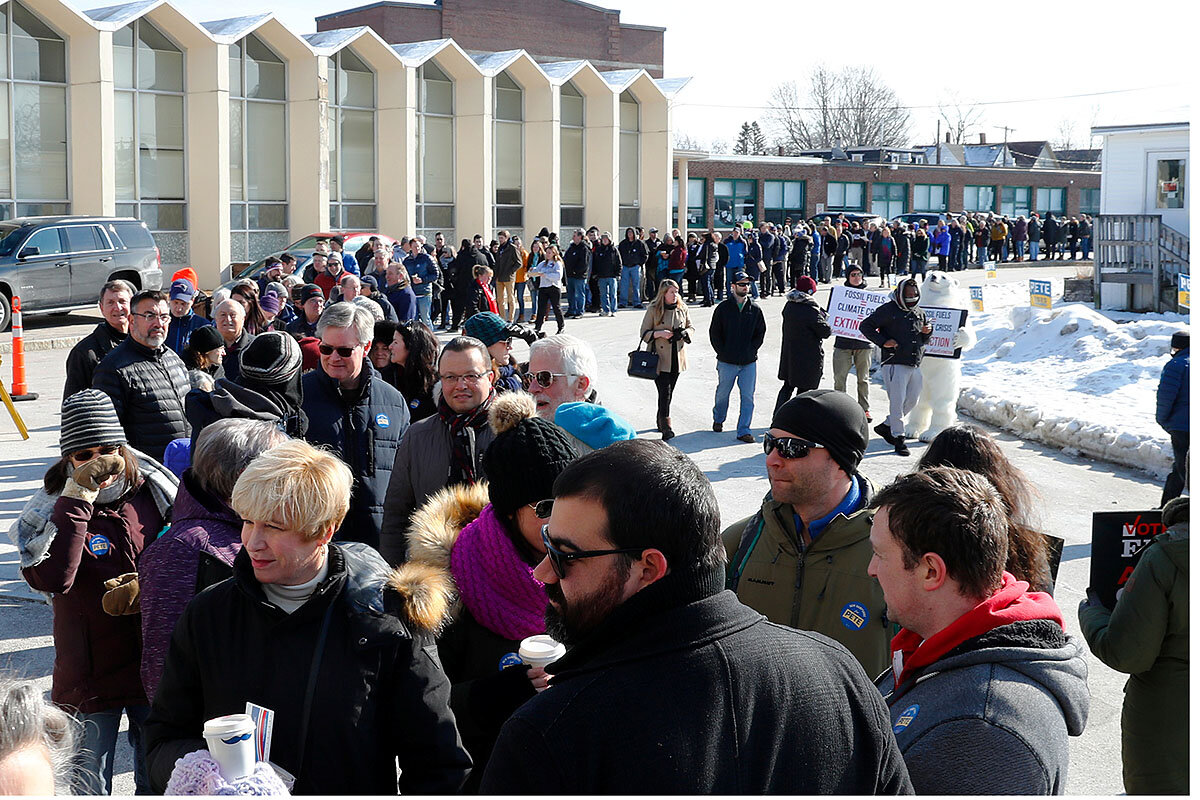‘We have to have hope, right?’ Democrats grasp for momentum.
Loading...
| Manchester, N.H.
For the past three years, Democrats have drawn fuel from a collective sense of outrage. But as New Hampshire prepares to register its choice for the Democratic nominee on Tuesday, there are signs that some of that anger may be fading into something more like weary resignation.
“So many people, myself included, have gotten to the point where it’s like, ‘Trump did this!’ and I’m just like, ‘Yeah, whatever,’” says Emily Hay, an energy efficiency coordinator from Tilton, New Hampshire.
Why We Wrote This
Democrats have been counting on a sense of urgency to drive voters to the November polls. But while some see a fire burning, others are sensing they may have to battle a “weary resignation.”
Last week, in particular, was a kind of dispiriting exercise in futility for Democrats. President Donald Trump’s impeachment trial ended with his long-expected acquittal by the Senate, the Iowa caucus fiasco raised serious doubts about the Democratic Party’s competence, and turnout among Iowa Democrats was far lower than in 2008 – despite predictions that it would smash records.
“It’s hard to be optimistic with everything we’ve seen,” concurs Ms. Hay’s husband, Russel. Still, he views recent events as more of a temporary setback. And he doesn’t see a widespread apathy among Democrats.
“I think there are enough young people who are angry,” says Mr. Hay. “I think there is still a fire burning.”
In between jokes about needing her ice skates on New Hampshire’s sidewalks, two-time Olympic medalist Michelle Kwan lays out why she believes former Vice President Joe Biden should be the Democratic Party’s nominee. Mr. Biden, she tells the crowd gathered at the Rex Theater in Manchester, is the only candidate who can beat “you-know-who.”
There’s a pause, and then a feeble smattering of applause.
Beating “you-know-who” has been a defining theme of this Democratic primary contest, with candidates and voters alike describing Donald Trump’s presidency as a kind of national emergency. For three years, Democrats have predicted that feelings of outrage and urgency on their side would drive massive numbers of voters to the polls next November – as happened during the 2018 midterm elections.
Why We Wrote This
Democrats have been counting on a sense of urgency to drive voters to the November polls. But while some see a fire burning, others are sensing they may have to battle a “weary resignation.”
But as New Hampshire prepares to register its choice for the Democratic nominee on Tuesday, there are signs that some of that anger may be fading into something more like weary resignation.
Last week, in particular, was a kind of dispiriting exercise in futility for Democrats. President Trump’s impeachment trial ended with his long-expected acquittal by the Senate, and his Gallup approval rating reached a new high. The Iowa caucus fiasco raised serious doubts about the Democratic Party’s competence, and did little to winnow its unwieldy field of candidates.
Notably, turnout among Iowa Democrats was far lower than in 2008 – despite predictions that it would smash records – leading many to wonder if the party may suddenly have an enthusiasm problem.
“I think there’s a malaise settling in on the Democratic Party,” says Andrew Smith, director of the University of New Hampshire Survey Center. “You can only stay angry for so long.”
Over plastic foam plates of lo mein in the Mall of New Hampshire’s food court, Emily Hay says she plans to vote for Vermont Sen. Bernie Sanders on Tuesday. But she’s feeling pessimistic about the Democrats’ chances of beating the president in November.
“So many people, myself included, have gotten to the point where it’s like, ‘Trump did this!’ and I’m just like, ‘Yeah, whatever,’” says Ms. Hay, an energy efficiency coordinator from Tilton, New Hampshire. Her mother, Polly Hayden, agrees, saying the Senate’s recent acquittal of the president only discouraged her further.
“It’s hard to be optimistic with everything we’ve seen,” concurs Ms. Hay’s husband, Russel.
Still, he views recent events as more of a temporary setback. And he doesn’t see a widespread apathy among Democrats.
“I think there are enough young people who are angry,” says Mr. Hay. “I think there is still a fire burning.”
“I think it’s a toss-up”
Certainly, the fire was there in 2018. The midterm elections saw the highest voter turnout in four decades, helping Democrats win back control of the U.S. House of Representatives with the largest margin of victory for a midterm in modern history.
But replicating that playbook again – given four years of a Trump presidency that included nonstop controversies from a special counsel investigation to an impeachment – may prove more difficult. Not only has Mr. Trump emerged from all those events largely unscathed, but many voters are also expressing a sense of fatigue.
At the same time, the all-consuming focus on Mr. Trump has made it hard for any of the Democratic candidates to gain traction. And while elections involving sitting presidents often play out as referendums on the incumbent, the president is already working to define his opponents in negative terms.
Just a few tables away in the food court, two women eating Auntie Anne’s pretzels describe President Trump as “the best of the worst.” When asked if they would support any of the Democratic candidates, they throw their heads back and laugh.
“No way,” says one of the women, as her friend vigorously shakes her head. “Not a chance.”
While an app malfunction and other irregularities delayed the final results in Iowa, about 176,000 Iowans participated in last week’s caucus – a slight increase from 2016, but still 62,000 voters short of 2008’s record-breaking numbers.
Republicans, on the other hand, saw more than 30,000 Iowans turn out in a largely symbolic show of support for the president – “smashing turnout records” for an incumbent, according to the Iowa GOP.
Many Democrats admit to feeling particularly apprehensive, as Mr. Trump’s prospects for winning reelection appear to be improving.
Waiting in a snaking line to see Sen. Amy Klobuchar in Salem, New Hampshire, on Sunday, Denise Ouellette, a voter from Massachusetts who plans to support Pete Buttigieg, says she keeps hoping something will come out about the president to undermine his support.
“Leaders embody our nation,” she says, her voice beginning to quaver and her eyes filling with tears. “They’re supposed to embody our value system.”
Ms. Ouellette’s husband, Tom, believes the Democrats’ best chances of winning in November would be with Senator Klobuchar or Mr. Buttigieg. But he’s not overly optimistic.
“I think it’s a toss-up,” says Mr. Ouellette. “I think it’s entirely possible that even with everything Trump’s done ... that he’s still there” in 2021.
“It’s going to take a movement”
To be sure, some argue the events of the past week may have actually helped to fan the flames for Democrats. Although New Hampshire’s secretary of state cut his initial turnout projection by 80,000 votes, he is still predicting a historic turnout of 420,000 on Tuesday.
Carlos Cardona, chairman of the Laconia Democrats, says Democratic enthusiasm in his town – which voted for Mr. Trump in 2016 before voting for a Democratic congressman in 2018 – surpasses anything he saw ahead of the 2018 midterms, or even the 2008 election.
“I’m feeling the energy on the ground a lot more than ever,” says Mr. Cardona. He knows people who have taken a week off from work to canvass for candidates, and says his own door has been knocked at least 17 times.
Mr. Cardona expects record turnout on Tuesday – and is anticipating a big victory for Senator Sanders, who won the state in 2016, and is currently leading in most polls there.
In the run-up to the Iowa caucuses, Mr. Sanders predicted the “largest caucus turnout” in Iowa history would propel him to victory. And although he appears to have won Iowa’s popular vote, he lags Mr. Buttigieg in state delegate equivalents, and he later admitted the turnout was a “disappointment.”
“I think all of us probably could have done a better job in bringing out our supporters,” he said in Friday’s debate.
Iowans under the age of 30 made up 24% of all caucusgoers – compared with 22% in 2008 – with the majority of them backing Mr. Sanders. But the overall number of young people who caucused was still down from 2008.
Of course, caucuses – which require showing up at a specific time, and committing several hours – tend to have much lower turnout than primaries. And many Sanders supporters are predicting a much bigger show of strength in New Hampshire on Tuesday.
After hosting a debate watch party on Friday night, David Robin got on a midnight Greyhound bus in New York City to canvass for the Vermont senator. By dinnertime on Saturday, Mr. Robin still hadn’t checked in to his room at the nearby Econo Lodge.
“It’s going to take a movement like ours to beat a movement like [Trump’s],” he says.
At other candidates’ events, many rallygoers – a high percentage of whom appear to have traveled here from other states – say they’re similarly determined.
“I am not one of the people who are worried that this is all chaos and disaster,” says Chris Bastian, a transportation planner from the New York City borough of Brooklyn, waiting in line to see Mr. Biden in Manchester.
But Mary Aarons, a book publisher from Massachusetts, admits to feeling apprehensive about November. Before getting in line to see Mr. Biden, she was chatting with the owner of a nearby pastry shop – noting how empty Manchester seemed the Saturday before the primary. At this time in 2008, the pastry shop owner told Ms. Aarons, the place was buzzing. The streets were packed.
“I have to remain optimistic, though, because we have to have hope, right?” says Ms. Aarons. “I can’t even conceive of the alternative.”
Staff writer Christa Case Bryant contributed to this report.












